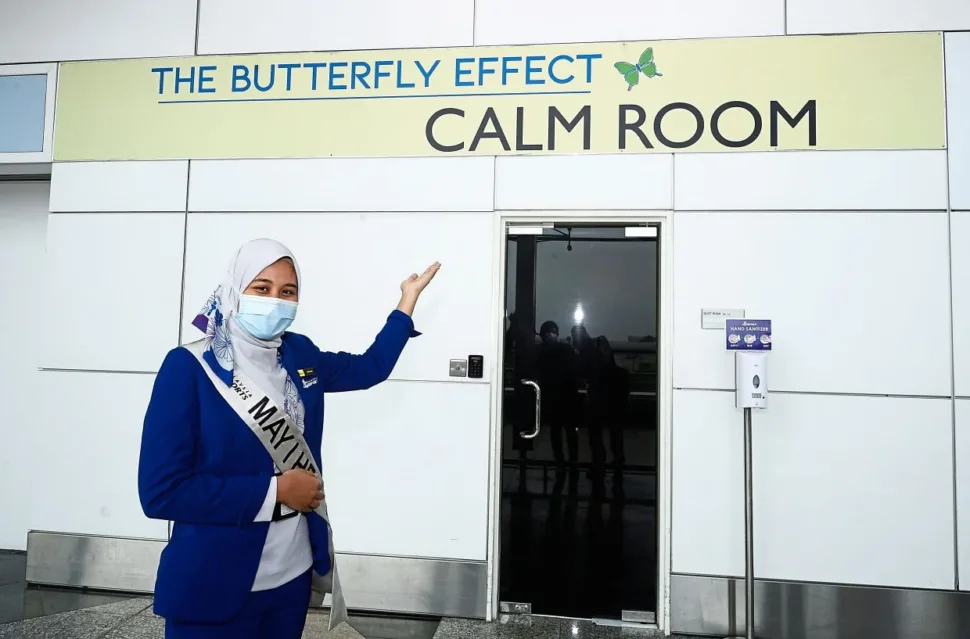11 April 2021
While most of us treat flying as something routine, the same cannot be said of those with autism as well as other “hidden disabilities” such as ADHD (attention deficit/hyperactivity disorder) or global development delay (GDD), among others.
For children with special needs, traversing the airport and boarding a plane is an “event” that comes with change in routine, noise, unfamiliar surroundings and crowds, all of which can overwhelm the child, leading to meltdowns.
Thankfully, KL International Airport (KLIA) is stepping up to serve this special segment by providing comprehensive services to these families from the the minute they arrive at the airport until they board their flight.
Through KLIA’s “Butterfly Effect” initiative, which is part of Malaysia Airports Holding Bhd’s (MAHB) CSR for special needs customers, these passengers will now be able to relax before their flight in a Calm Room on Level 5, a haven shielded from outside noise and equipped with multiple activity stations.
In total, 10 sensory walls were installed across KLIA and KLIA2 to provide something to occupy special needs passengers via tactile, visual and auditory play.
There is also a dedicated drop-off zone on the kerbside of the terminal entrance door as well as special priority lanes at the Immigration and Customs counters for all Butterfly Effect travellers.

MAHB corporate communications general manager Nik Anis Nik Zakaria said the Butterfly Effect initiative was the company’s efforts to raise the bar.
“We’ve already had initiatives in place to help physically disabled travellers but we wanted to do more for those with hidden disabilities.
“So far, hundreds of airport personnel have been trained by the Autism Behavioral Centre (ABC) on how to assist such passengers.
“This initiative started in 2019 and was launched in 2020 but due to the pandemic, we had to close the facilities. Now, we are taking advantage of the quiet time to introduce it again, ” said Nik Anis after a media tour of the Butterfly Effect initiative on Friday.
She said the name Butterfly Effect was chosen as MAHB believed in the theory that a small change in one state can result in a big difference later, and revealed that the initiative would later be expanded to other airports across the country.
Nori Abdullah, wife of Science, Technology and Innovation Minister Khairy Jamaluddin, hopes that families who have struggled to take flights in the past could now travel more comfortably.
Nori, whose 12-year-old son Timor Abdullah Jamaluddin has autism, said KLIA was one of the few airports taking steps to cater to individuals with hidden disabilities, and hoped others will follow suit.
“This is an initiative that can change the lives of families with differently-abled individuals.
“I hope that this will catch on because we need this in our lives, ” she said when met at the event.
In order to use the facilities of the Butterfly Effect programme, passengers must first be registered through the MAHB website three days prior to their flight.
They also need to bring their Kad OKU or a letter from any hospital or clinic confirming their condition.
At the KLIA information counter, passengers will be given a complimentary Butterfly Kit containing a “Butterfly” lanyard, access code to the Calm Room, and locations of the sensory walls.
Passengers or their guardians must also wear the Butterfly lanyard for easy identification.
In conjunction with World Autism Awareness Day (April 2), passengers with special needs and their families can try out the services via a mock airport journey experience called “The Butterfly’s Adventure”.
More information will be announced on www.malaysiaairports.com.my and its social media channels, with registrations done online.
Source: www.thestar.com.my
Site Search
Did you find what you are looking for? Try out the enhanced Google Search: